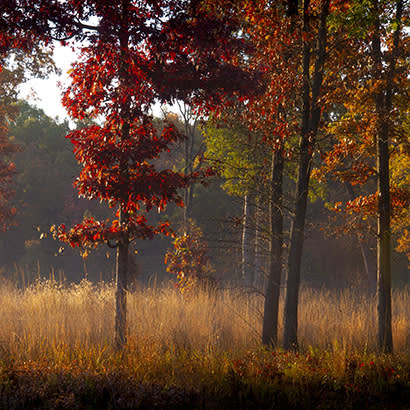
For an enhanced digital experience, read this story in the ezine.
As I scanned the perfectly straight rows of densely spaced pines at Metroparks Toledo’s (Ohio) Oak Openings Preserve, I knew we had a problem. Planted with enthusiasm by earlier generations of conservationists to stabilize soils after the dust bowl, the original intent was to harvest them for timber. But in the flat northwest Ohio landscape dominated by farm fields and woodlots of native hardwoods, the pines quickly became a popular destination for park visitors seeking seclusion and the hint of iconic western landscape the pines inspired. In deference to the public, previous park managers didn’t have the heart to follow through with the original plan. Now the pines were finally succumbing to lack of sunlight — no longer able to produce enough sap to expel bark beetles or resist summer droughts. Within a couple decades, many would be dead. To my surprise, “adaptive resource management” was the solution to my problem.
The Benefits Outweigh the Challenges
Adaptive resource management is a structured, iterative process that allows for robust decision-making in the face of uncertainty by learning from previous management outcomes. In practical terms, it simply means: develop a plan, implement it, monitor the outcome, evaluate and communicate the results, and use what you’ve learned to adapt and improve future actions. While this cycle seems perfectly intuitive, it can be challenging to implement effectively due to competing demands on our limited time and financial resources. Real-world challenges and information gaps often keep us from fully completing each step before moving on to the next. But each repetition of the cycle expands our knowledge, and I can attest that adopting this management philosophy will save your agency many future headaches and ensure that your actions are sound and defendable in the face of public scrutiny.
Our plan for the 400 acres of non-native pines representing a tenth of our preserve’s land area was to immediately harvest all plantings at risk of collapsing within 10 years (100 acres in total) and restore these sites to native prairies. We knew this would not be an easy sell to many park visitors who would simply see us cutting down trees that were obviously still living. However, our plan was well supported by previous monitoring efforts using forestry metrics (like stand density and a live crown ratio) that confirmed most trees were well beyond the threshold of viability. In collaboration with university researchers, we had monitored the results of a smaller pine removal project 14 years earlier, showing overwhelmingly positive benefits for pollinators, ground-nesting birds and state-listed rare plants. We vigorously communicated these results in journal articles, public lectures, online videos, newspaper editorials and community open houses, so when it came time to implement our plan, we were ready.
Monitoring Our Legacy Pines
During logging operations, we maintained consistent messaging and open communication with park visitors, pausing work at regular intervals to offer tours of the impacted areas. We did not shy away from the fact that the work was unsightly, but we continuously reinforced that based on the facts, the short-term loss was worth the long-term gain. Following completion of the work, it was back to monitoring. We documented nearly 300 native plant species emerging from pine clearings in the first year. Responding to legitimate criticism from local naturalists that we had not sufficiently documented use of the pines by nesting birds prior to cutting, we initiated a new study with university researchers to analyze breeding bird use of the remaining pines to inform future management. Today, we continue to closely monitor the health of our legacy pines. We celebrate them with park visitors as evidenced by the popular destination known as “the Spot.” We collect and analyze new data as it becomes available, and we prepare for the next round of planning. While the adaptive management cycle never really ends, it leaves me with the confidence that when action is needed, we will be ready.
Tim Schetter, Ph.D., is Director of Natural Resources for Metroparks Toledo.

